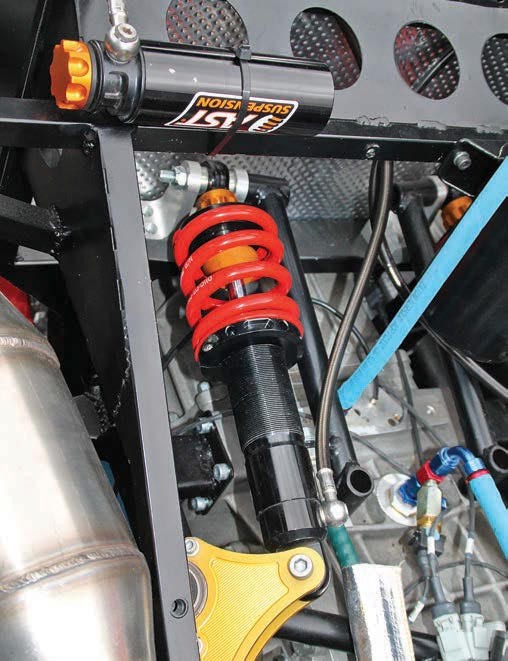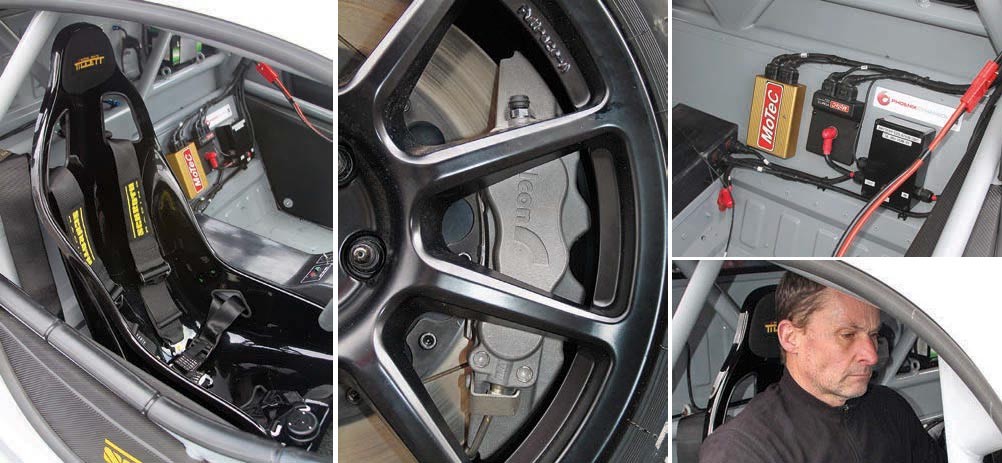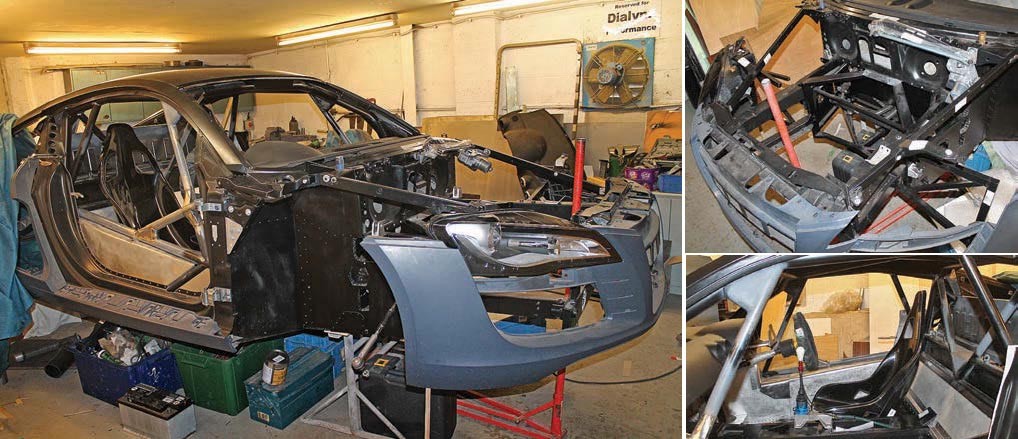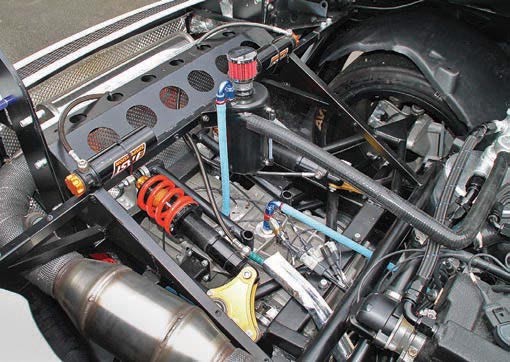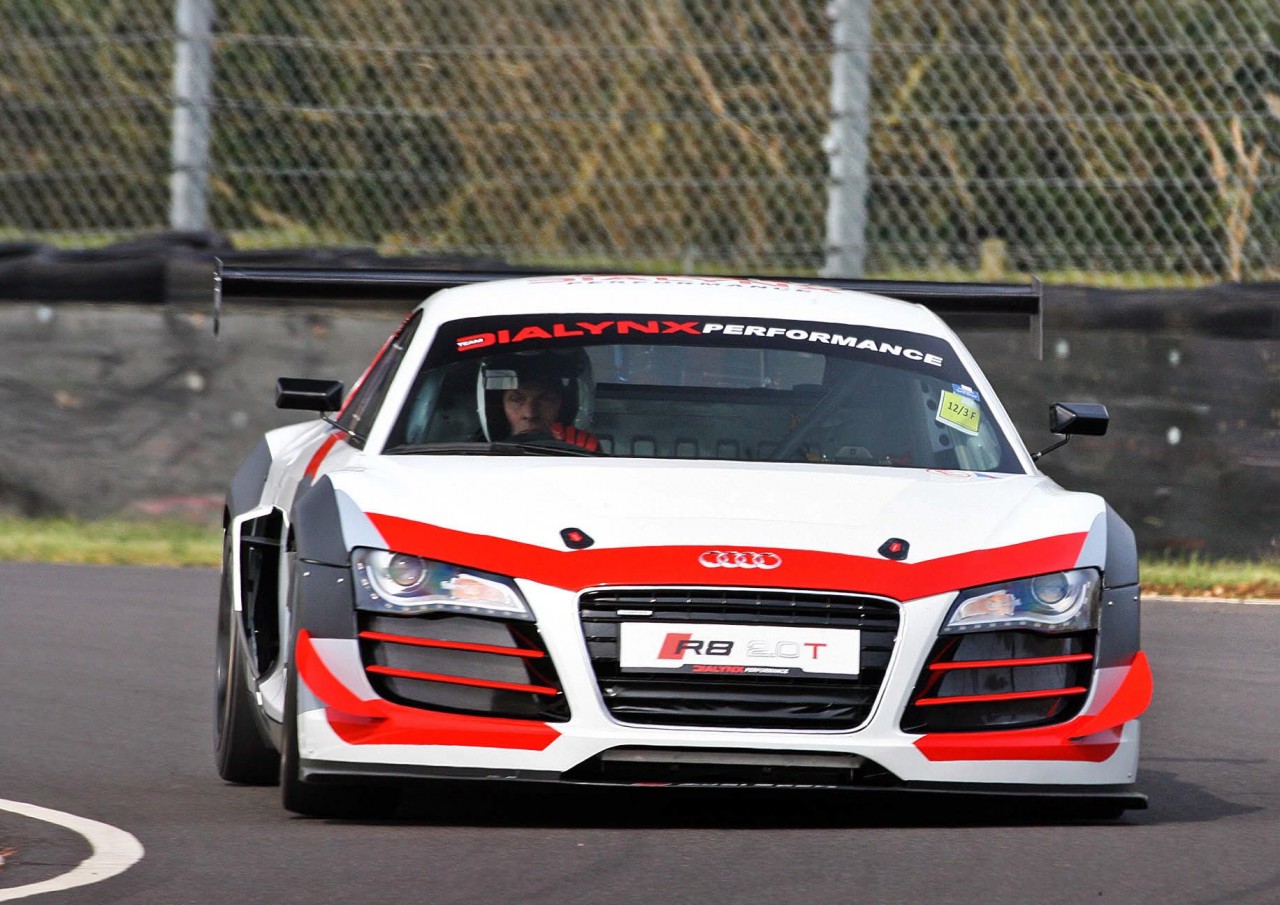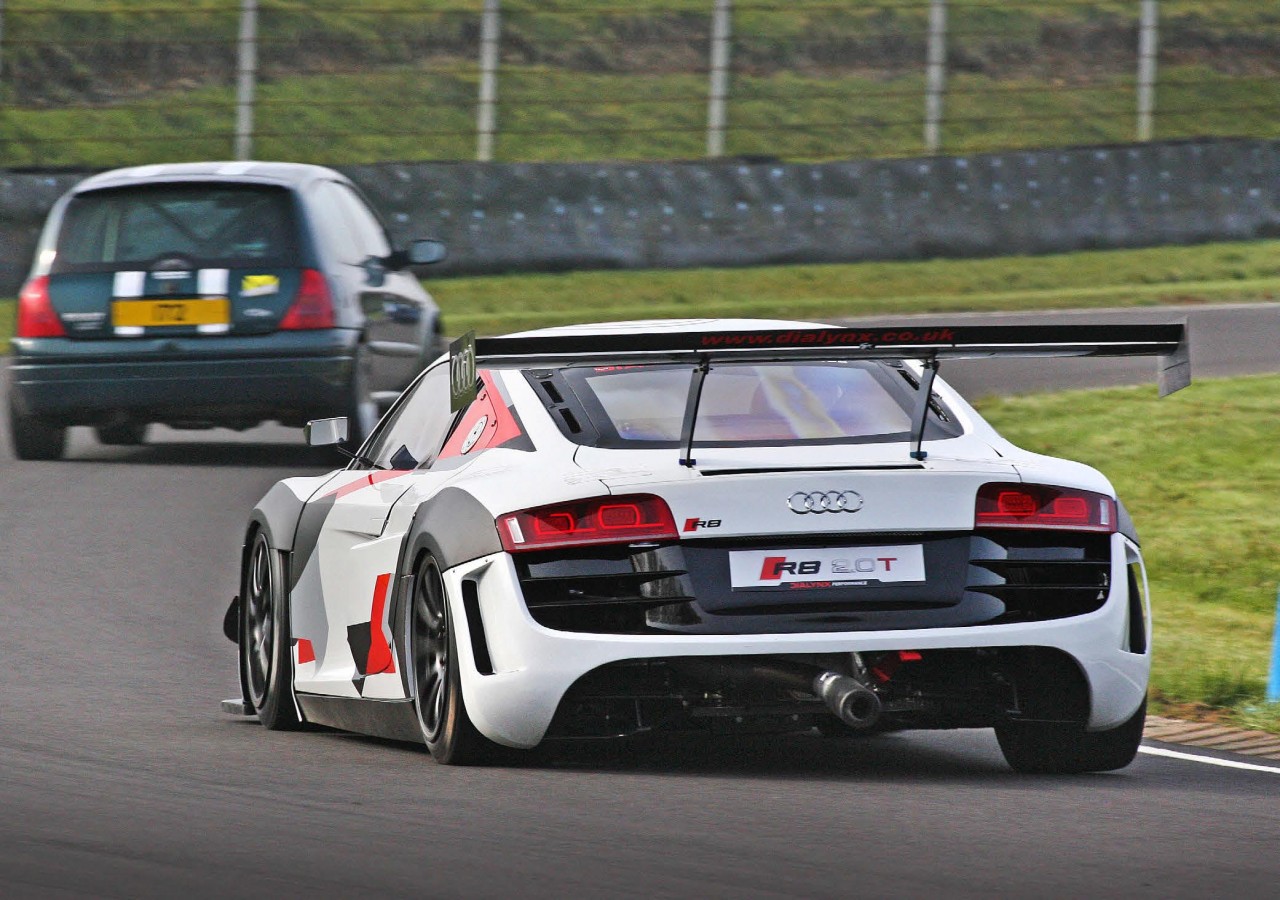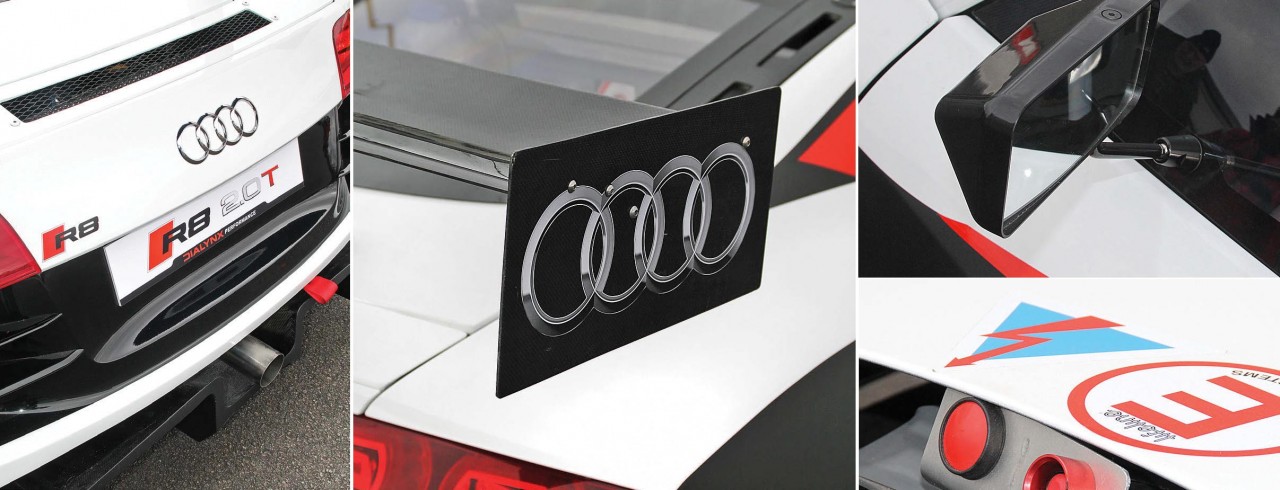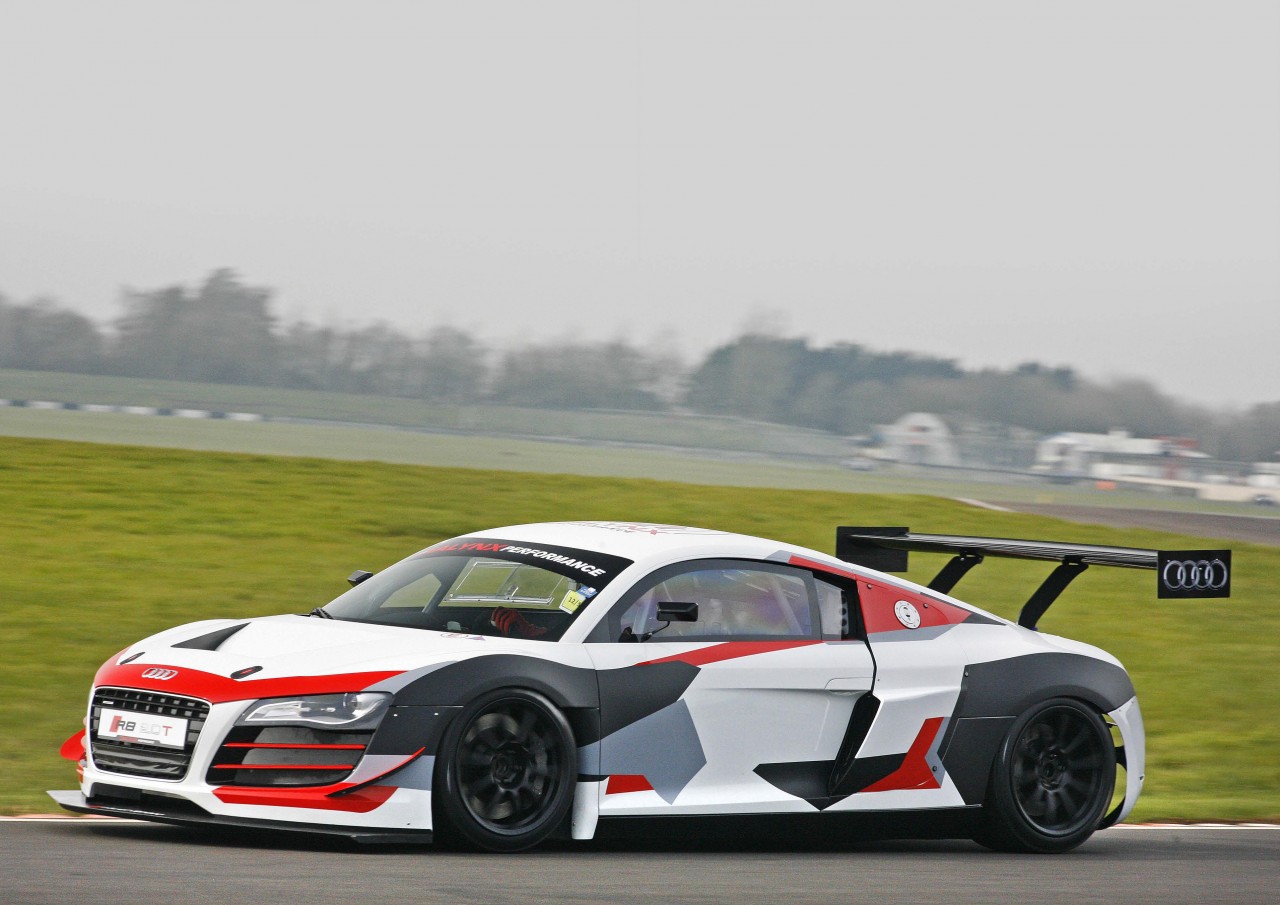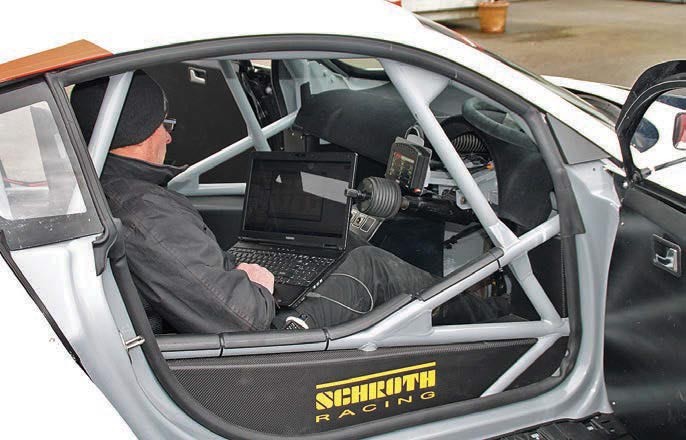Motorsport – Dialynx Performance R8 2.0T racer / R8 Audi Typ 42
Lightweight is usually a term of gentle derision, but here’s a box-fresh Audi R8 racing car resplendent in Audi Sport colours that’s just emerged from a serious diet. Compared with 1560 to 1620 kg for the showroom model, this race-ready version weighs just 956 kg without fuel or driver. But there’s far more – or less? – to this R8 than meets the eye. Every inch the real racer, compared with Audi Sport’s 1295 kg R8 LMS cars, this one really knows how to look after itself…
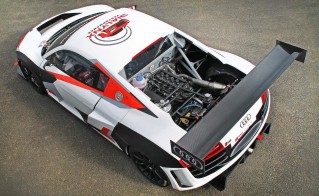
Built by Keith Murray, a man who’ll be well known to readers of Audi Driver, his company Dialynx Performance has been maintaining, tuning and totally overhauling everything from road-going to competition Audis since 1988, including the creation of many shortened wheelbase Audi quattro Sport replicas.
Keith also puts his skills to the test as a seasoned motorsport competitor, having campaigned two successive quattro Sport hillclimb cars; the first used an ex-works Audi quattro Sport rally car bodyshell, while the second was a shortened Ur quattro with all the superfluous overweight rally parts jettisoned. It even lost its roof gutters in the preparation exercise that followed – just a flavour of what follows here…
After three seasons racing an A4 quattro in the Castle Combe Saloon Car championship from 2005-2007, winning 13 races and coming second overall in the class-based championship, Keith took a sabbatical while he worked out that the best tool for sprinting and hillclimbing in the UK was quite clearly a turbocharged 1.4-litre 80 quattro.
Another benchmark exercise in flyweight competition car building, it shook the establishment. Immaculately assembled to the absolute letter of the UK MSA Modified Production sprinting rules, with a rear half cage and door bars, lightweight kevlar / composite front panels, wings and bonnet, running a downsized 1.4-litre 16-valve turbo engine, it broke umpteen hill records in the sub-2.0-litre Modified Production category and even took prize money. Back in 2012, Keith took it to GTI International and scorched up the quarter mile in 10.568 seconds. Not your everyday 1.4-litre car, by a long way!
Context set, there was no way this latest Audi R8 was getting away lightly. It’s early March and we’re at its first shakedown at Turweston airfield to start building the data set and fine-tuning it for its Castle Combe circuit debut in late March. So far, it has only been run on the rolling road and driven onto the trailer but as Keith warmed up the car, long-time helper and former racer Dave Elkes commented succinctly: ‘I dread to think of the man-hours that have gone into this!’
A long way from the initial plan for a roadgoing trackday car to the hugely re-engineered flyweight GT racing car it has become, Keith now has his eye on a combination of GT racing and European hillclimbing in the Berg Cup. It’s something he’s gained an appetite for in the last two years with the 80 quattro, but Keith has also looked beyond the Castle Combe GT series and toured other UK GT series in order to ensure that the car is eligible and relevant for use elsewhere.
The R8 bodyshell was originally sourced in 2008, although work only started in earnest in October 2014 and it was 95 per cent completed at Audi Driver International last October. It was then displayed at the Professional Motorsport World show in Cologne a month later, where an intriguing conversation took place. After looking closely at the car an employee of Audi Germany pronounced: ‘You’ve already done it!’ Thinking it had a fourcylinder TFSI engine, the indications were that Audi itself is considering a four-cylinder downsized hybrid R8 to rival BMW’s i8. ‘He was asking all sorts of questions as he thought it was just a straightforward TFSI engine that I’d put in there,’ explained Keith.
Anecdotes aside, the build of the racing car and relatively free regulations for both championships led to some serious re-engineering plans for the R8. The car will sit within the Castle Combe over two-litre Sports, GTs, Saloons, Touring Cars and Silhouettes class, which broadly encompasses productionbased cars that are highly modified. Entered in one of the classes which will win races, Keith noted, ‘It’s fairly open but also structured. Silhouette cars are allowed but they’ve got to be production-based cars. Ultimately that’s what this is. It’s a silhouette type of car because, although it’s got the bodyshell of a standard R8, underneath all the front suspension, all the rear suspension, engine, running gear… it’s all bespoke.’
The shell was actually brand-new, straight from the production line, saving time cleaning underseal off. A comprehensive in-house CDS (Cold Drawn Seamless) unalloyed carbon steel roll cage was then installed into the aluminium body at Dialynx, based on the FIA homologated cage, including a comprehensive door bar structure. To comply with the motorsport governing body regulations and simultaneously stiffening up the structure, it was also extended to create attachment points for the rear-mounted engine, gearbox and rear suspension assembly.
Such is the freedom in the regulations that the R8’s pre-existing rear suspension structure has been removed. Added to it are foam-filled aluminium clad crash structures across both door apertures for up-to-date safety.
Engine
The engine decision was iterative. The original V8 wouldn’t fit within the space behind the bulkhead, once the planned gearbox was measured up. With the off-shelf sequential racing gearbox from Elite Transmissions fitted, the driveshafts would be too far backwards and the resulting wheelbase would fall outside the bodywork and also outside Audi R8 LMS homologated specification, a recurring aim throughout the build. So the gearbox governed everything.
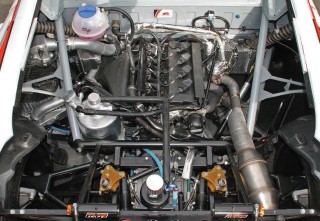
The regulations prevent the bulkhead being moved forward to create room, so the remaining more-compact choices were to fit an Audi S4 V6 twin-turbo engine, with twin intercoolers, or a lighter four-cylinder with a turbo – a 2.0-litre engine provisionally built for the 80 hillclimb car – and the need to accelerate the R8 project leap-frogged it into the back of the R8. Such is the compactness of the packaging that the cambelt is less than an inch from the rear bulkhead, but with just a single turbo and four cylinders, everything’s simpler. And, of course, lighter.
Revealed initially on Facebook last September, with the car on EPS Motorsport’s rolling road, at face value it had a 4-cylinder VW Golf / Audi 80 16V engine, akin to that in the aforementioned 80 quattro, but there the similarities diverge. Not content with shedding four cylinders of weight from the R8 production spec, the plot thickened as it transpired to have a less common Audi A4 / VW Passat-originated aluminium-block engine.
The production 2.0-litre ALT-coded engine is a normally-aspirated 20-valve, but in this instance Keith has fitted the previous generation Mk 3 Golf GTI 16-valve ABF head. The rationale? Although the 16-valve head is less efficient – notably the shape of the combustion chamber – the valvetrain is simpler to tune, and very tried and tested. To convert to solid lifters is more involved on a 20-valve, with its small tappets, hence choosing the 16V even though the valvetrain is heavier. Besides, it was to be an upgrade for the Audi 80!
Parts bin engineering at its finest, with just a few redundant oilways to close off from the 20V block-to-head to mate the two, but the longnose crank of the ALT and the cam pulley of the 16V don’t line up when placed on top of each other, and Keith confirms the ‘crank, cam and water pump all had to be re-engineered to line up.’
A very key ingredient to this engine is an Owen Developments Garrett competition HTA turbo, boosting up to 2.1 bar, with a Tial wastegate. Mounted low down on the driver’s side, for weight distribution, that equips it with power capability far in excess of the 128 PS of the production offering.
An ALT engine was developed to produce 500 bhp for another Dialynx customer some years ago, so with more work and the latest MoTeC M800 ECU – Dialynx has been a MoTeC distributor for many years – the result is a staggering 650 bhp at 8000 rpm. That’s five times the original output of the block and over four times the output of the head in factory spec! Maximum torque is 420 lb.ft. at 5000 rpm and the engine will rev to 9000 rpm, though by then the power has peaked. This level of output for an engine with the non-pent roof 16-valve head is very high. Admittedly, it runs on MSA-compliant 100 RON-limited race fuel, not 98 RON pump fuel, the race-blend purity enabling cam timing to be cranked up just a little more, but 650 bhp is impressive in the context of non-drag-racing, non-nitrous-injected 2.0-litre four-cylinder VW motors.
Not surprisingly, the internal components are given a benchmark race engine uprate to cope with the significant power increase. The ALT aluminium block provides the canvas while Arrow 144 mm connecting rods, a Farndon 92.8mm billet crank and modified Wossner 82.5mm pistons give 1984cc. In the head there are 1 mm oversize Supertech racing valves, Supertech titanium lightweight valve spring caps and springs, solid rather than hydraulic cam lifters and Piper cams. A Titan dry sump system with an in-house sump and an AH Fabrications tank provide the lubrication.
The engine is fuelled with four huge 1450 cc Asnu injectors and the Garrett / Spec-R rear nearside-mounted intercooled inlet charge arrives through a modified Audi A4 SEM Motorsports inlet manifold with an Audi RS 4 V6 fly-by-wire throttle body, SEM fuel rail and Beru TFSI coil-on-spark-plug coil packs. With sequential injection instead of wasted spark, the ECU uses the old distributor hall sender as a cam sensor, in addition to a crank sensor. Gases exit to the turbo via an in-house fabricated 304-grade stainless-steel exhaust manifold. A WOSP race alternator further reduces engine weight.
From prior experience, the 16V head’s breather system is deficient once turbocharged, unlike the 20V engine which has an OEM breather system in the cam cover, so it now uses the Spec-R breather design originally employed on the hillclimb 80 quattro.
The engine is fuelled through twin Bosch 044 pumps, drawing petrol from one of two tanks that have separate feeds. A larger 45-litre tank, for Castle Combe GT racing, is fitted behind the passenger side bulkhead and there’s an extra 10 litres on the driver’s side for the short Berg Cup hillclimb events in Europe. The main fuel tank is on the left-hand side for weight distribution purposes. A late change of design was required when the Castle Combe series increased the race length from 12 laps to 15, and the fuel capacity had to be increased.
Gearbox
By comparison, the gearbox is relatively simple. The Elite ‘TXL 600 6S’ 6-speed sequential transmission weighs a notinsignificant 85 kg and is rear-wheel-drive only, as are Audi’s works-prepared R8 LMSs, since their GT3 regulations preclude fourwheel drive. Here it’s a case of lightness and simplicity – that weight saving theme again. There’s a flat-gearshift system fitted, the MoTeC ECU cutting the sparks and ratcheting in the time gains at every turn. Two gearbox cooling matrices are fitted, on account of the transmission’s twin spray facility. Traction is aided with an Elite-supplied plate LSD and the power is transmitted to the rear wheels by stock R8 driveshafts.
The engine and gearbox combined are fitted on a bespoke rear subframe, with two visible bolts on the upper half of the rear subframe connecting to the rear chassis structure. Once the lower wishbones are undone, two bolts for the engine mounts are removed and the whole rear of the car can be unbolted and literally rolled out, making the powertrain package a completely separable component.
Connecting the two is a 184 mm sintered triple-plate AP basket clutch, and a steel Helix Autosport billet flywheel. The flywheel bolts had previously tried to make a bid for freedom on the 80 quattro and so Cosworth flywheel bolts are used, with suitably-keen Loctite.
Suspension
The suspension was originally measured up from a Lotus Elise and then evolved via Audi R8 LMS homologation documents to the final specification. Keith modified all the mounts – indeed, the front and rear suspension arms have all been re-made in tubular steel.
In terms of wishbone pivot points they are ‘all the same as the R8 LMS, which is different to the standard car. So I had to do a few mechanical changes to get those in the right places. It’s all LMS underneath there.’ Said Keith ‘I’ve changed the damper positions and damper mounting points, just because I don’t want to run Audi dampers. I can then run my own dampers.’
If all of this sounds like wholesale re-engineering, to the point where most would have thrown the spanners down, don’t feel alone! It’s enough to boggle the mind of the keenest car enthusiast. There’s so much more in the detail that it all makes the business of short-wheelbase Audi quattro conversions seem like something of a walk in the park.
To control all the suspension movements, AST remote canister two-way adjustable dampers are fitted front and rear, rather than more exotic three-way and upwards, Keith noting ‘If you start getting too complicated with the adjustment then you get lost quite easily. You need a chassis engineer then!’
The rear dampers operate on a bell-crank system, resulting in dampers mounted inboard and longitudinally atop the gearbox. With this R8 being something of a flyweight, the pre-testing Eibach spring poundages are correspondingly lower than the LMS car: 1000 lb at the front and 700 lb at the rear. The car has a 45:55 front to rear weight distribution.
It’s not an inconsiderable skill to re-design a race car suspension from scratch using dimensions from other influences, but to answer the looming question of whether computers were involved in the build of a car like this, the answer is no! ‘All of this was done with hand measurements and drawings.’ In fact, the R8 LMS’s FIA homologation documents were a phenomenal resource and it was these detailed books from the various versions of the Audi Sport R8 that enabled Keith to ensure that everything from suspension to the front splitter, to radiator sizes, to brake pot sizes, all comply with homologated dimensions.
‘Items like that front splitter are homologated. You could run a standard car and put that on it. All these items that are homologated, are not homologated as a whole.’
There was just a blade adjustable front antiroll bar to fit and a corresponding standard adjustable-type bar at the rear.
The keenness to follow with the Audi Sport homologation prompts the comparison of this narrow body R8 with the wider Audi Sport LMS R8. It’s deceptive because it makes it look like a wider car, but actually the underpinnings don’t require the wide body to house its homologated suspension, again as Keith explains: ‘It’s only the three body panels. Two rear wings and the bonnet. In the original cars they used standard (width) wishbones and put big wheels on them. If you look closely at an LMS, the track is almost identical to a road car. The bodywork sticks out another inch. The gap between the wheel and the (LMS widened) body is quite big. They run slightly different offsets but the wheel sizes are the same.’
Bodys hell and chassis
The theme of lightness continues with the bodywork and aerodynamics. The front wings are the original aluminium, as are the rear wings, while the engine cover is carbon with a polycarbonate window. The bonnet is partoriginal aluminium with a large fibreglass radiator exit duct towards the rear, apeing modern race-car style flow-through cooling, using the passing air over the top to the car to drag the air through the R8 LMS-dimensioned Pace radiator beneath. The doors remain the factory aluminium, albeit lightened internally and fitted with aluminium inner skins, finished off with lightweight Lifeline racing mirrors, and Plastics4Performance polycarbonate side windows, whilst the front and rear bumpers are carbon kevlar.
Aerodynamically, the production R8 has a flat cabin floor, augmented with a sizeable front splitter – to R8 LMS homologated dimensions – combined with an air-smoothing flat underfloor. Dive planes are added on the front bumper corners, plus cutaways to clear the air from the rear of the front wheel arches and reduce the high air pressure that raises the car. The carbon rear spoiler itself apes the early R8 LMS design, albeit with twin vanes: ‘The aero package on there is about as close as I can get to the R8 LMS. They run a singlepiece rear wing because they’re only allowed a single element, but we’ve got the two-element wing as the size of it will give more downforce than the single element version and it’s got so much more adjustability.’
A rear diffuser tidies up the airflow underneath the engine bay all the way forwards to the cabin. It all combines to produce a fully flat underfloor to aid passage through the air.
Interior / switchgear
The interior is all about pure function, as you’d expect. As in the 80 quattro, a trademark Tillet B6F bucket seat is the most obvious featherweight furnishing, fitted with a sixpoint Schroth harnesss. The dashboard shell remains but the instrumentation is the latest MoTeC C125 dash readout, in front of the quick-release Sparco wheel and Laranca boss.
Aside from the sequential gearshifter, the rest of the relatively scant interior is dominated with the carbon clad switch panel mounted low on the central ‘tunnel’ – sans propshaft of course – which contains all switches, from starting the car, to optional anti-lag system, to light switches.
The sophistication of this is deceptive and Keith explained he’s made considerable effort to ‘future-proof’ the build. ‘There’s 15 switches on the centre console and they are just CAN Bus’d to the MoTeC PDM15 power distribution module. It’s all controlled through that. So there’s no wires. Just a CAN cable’. Between the ECU, the dash, wheel speed sensors and suspension movement potentiometers, the R8’s data-logging capability is extensive. Then there’s launch control and the option of traction control.
There are no relays, no circuit breakers, and no fuses. It replaces the entire need for conventional electrics, reduces weight and simplifies wiring. A lightweight lithium-iron motorbike battery completes the electrics. The battery has even been fitted on the left, adjacent to the MoTeC ECU and power distribution module, to balance weight distribution with the driver on the right. There’s a box in the front footwell for a slave battery, if needed.
Connecting it all together is a wiring loom, made by Phoenix Dynamics, which is full of military-spec waterproof connectors, and yet it will be as light as possible. All of these minutiae add together, exude quality and really show how advanced and well thought out this car is. The clutch and brake pedal assembly has been replaced with a Tilton floor-mounted pedal box, which again moves weight down and provides front-rear adjustable braking, as well as dispensing with the servo. Top quality nonfloating disc Alcon brakes are fitted at each corner, 380 mm front and 355 mm rear disc diameters respectively, with six-pot front brakes and four-pot rears. Everything is again intentionally to R8 LMS specification, including the size of the brake pots, even though the Audi factory cars use Brembo components.
Curiously right-hand drive, unlike the LHD 80 quattro and also the previous Sport quattros, Keith noted that he had built the car so it could be run in either left or right configuration. ‘If I want to make it lefthand- drive, I can quite easily. There are no fundamental parts in the way. Originally, it was going to be a trackday car and I was going to put it on the road, so that’s why it’s right-hand drive, but it sort of evolved and it’s no longer a road car!’ The clockwise nature of Castle Combe may just have swung the argument, at least for now. A custom-built quick rack, 2.2 turns from lock to lock, points it all in the right direction.
Wheels and tyres
Tyres were settled on R8 LMS specification, feasible once wheel and then tyre size availability was established. ‘The front width is governed by gut feel on needing to be slightly narrower’ noted Keith about the 10-inch width, adding that a 12-inch on the front would be excessive, while the rears are – within reason – as large as possible to get all that power down. 255/635 R18 and 300/645 R18 front and rear Avon radial slicks were selected and a similarly-grooved wet tyre is available.
Tyre compounds vary and as the car stood at initial shakedown, with a soft hillclimb fronts and medium compound rears, ‘that is effectively our Berg Cup set-up’ where the car slots into the E1S2 open class for ‘productionbased but anything goes’ cars, such as ex-DTM. ‘It’s only for a bit of fun really’, Keith chuckles at the stiffness of such well-bred competition.
Conclusion
Taking stock, the game has long changed in race car building, and preparation quality is an area which builders take a lot of pride in. As with the 80 quattro hillclimb car, the fit and finish on this R8 is to an immaculate, purposeful standard despite its fundamental alterations. It’s an object lesson in taking an R8 and turning it into a flyweight racing machine with all the exterior looks of a factory car with race spoilers and splitters. A power to weight ratio of 639 bhp per tonne without driver is not an unenviable task, although Keith pointed out that the all-wheel-drive 750 bhp Audi S4 he built for a customer accelerated off the line quicker than this R8 ever will.
It’s certainly new racing territory with its output and handling dynamics, being a mid-engined, and very powerful rear-wheel drive car, and with aerodynamics. Keith admitted that he’d ‘never driven anything like it – 30-odd years ago I used to rally an Opel Manta which was rear-wheel drive, so it’s a new challenge!’ The car is geared for an eyewatering 185 mph.
The Castle Combe GT class lap record is currently just over one minute and nine seconds. Keith mentioned ‘I designed the car to do a 1.05, so that’s our target. Whether or not it’ll be capable of it, I don’t know. Wait and see. There’s one class above us, a faster class which is the four-wheel drive. Standing starts don’t help as they’ll be away and we’ll spend the next few laps catching them up. It’s very much an aero car. It’ll be interesting to see what it’s like.’
There’s an unfortunate footnote to the story, though, when Keith took the R8 to a track day at Castle Combe on March 12 to put it through its paces, after the shakedown at Turweston airfield had been cut short by an alternator that refused to charge below 3000 rpm.
Reporting that it had been running really well for several sessions, overtaking everything in sight, Keith then encountered an errant Caterham that had been let out on track just ahead of him as he thundered down the main straight at around 130 mph. Taking avoiding action as it moved sharply right across the track in front of him through Folly, Keith just clipped the Caterham on his left-hand side and was spun around and launched into the barriers, rebounding and rolling for several hundred yards down the track. Keith recalls ‘the Caterham coming out of the pits decided he wanted the same piece of track that I was on. He was doing about 50-60 mph and I was doing 120-130 mph…
I was knocked out as soon as the car hit the barrier!’ Unconscious for the duration and with a couple of cracked ribs incurred, Keith came round to find the R8 still running but the bodywork severely battered and the extremities of the suspension, the wishbones etc, somewhat rearranged.
It will take some time, but Keith is confident that he can repair it and be out racing again later in the season, with the added motivation of knowing just how superbly it was running on that first track session, as Keith reflected: ‘that R8 is quick – fastest car I’ve ever built! And the aero works amazingly. There were two more guys there but not on the same pace as the R8! It was as good as I hoped it would be… Maybe even better, as that was really the first proper drive I had in it…’
The following day and undeterred, Keith pronounced, ‘I’m up for a rebuild as soon as possible. I can’t stop thinking just how fast the car was… Brilliant!’ Reading between the lines, it’s clear enough from the truncated Combe test that the gut feel is this car could be a winner. Who knows, there might even be room for some further minor improvements in the process, as Keith is clearly not a man to do things by halves…
When it’s time for Take 2, with Dialynx’s background in creating interesting but also very clever cars, we wish Keith and the team the very best of success when they head out into the competitive world again.
Keith admitted that he’d ‘never driven anything like it…’
‘It’s an object lesson in taking an R8 and turning it into a flyweight racing machine with all the exterior looks of a factory car with race spoilers and splitters…’
Dialynx Performance Tel: 01793 772 245 www.dialynx.co.uk
‘The interior is all about pure function, as you’d expect…’
‘It’s all LMS underneath there…’ Keith Murray
‘If all of this sounds like wholesale re-engineering, to the point where most would have thrown the spanners down, don’t feel alone!’
‘The ALT engine with the MoTeC M800 ECU produces a staggering 650 bhp at 8000 rpm…’
‘Although it’s got the bodyshell of a standard R8, underneath all the front suspension, all the rear suspension, engine, running gear… it’s all bespoke.’ Keith Murray
‘There’s far more – or less? – to this R8 than meets the eye…’

